Reprinted from Dive Log May 2002 - "Annual Report from the Victorian Ships' Graveyard" by Rowan Stevens.
Introduction
On Sunday 23rd December 2001, Rowan Stevens, Mark Seewitz and Barrie Heard, supported by Geoff Stebbing and Claire Cooper, became the first people to dive Victoria's most recently scuttled wreck. The expedition was the culmination of 12 months planning and lead up dives. Recently, on Tuesday 9th April 2002, another group from Torquay were fortunate enough to also dive on the BAYONET, bringing the total number of visitors to the site at around 12 divers.
The HMAS Bayonet
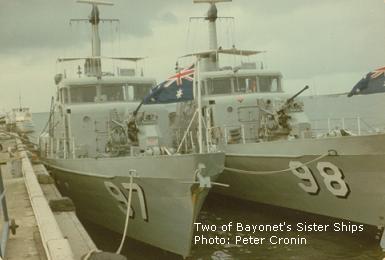 Laid down at Walkers Ltd, of Maryborough, Queensland in 1968 BAYONET is a vessel of 150-tonnes, having a length 32.6 m and a beam of 6.1 m. She has 20 identical sister ships, in the figure below are two of them. (On a recent visit to Sydney, I noticed HMAS ADVANCE, another of BAYONET's sister ships, tied up alongside the Maritime Museum Wharf at Darling Harbour).
Laid down at Walkers Ltd, of Maryborough, Queensland in 1968 BAYONET is a vessel of 150-tonnes, having a length 32.6 m and a beam of 6.1 m. She has 20 identical sister ships, in the figure below are two of them. (On a recent visit to Sydney, I noticed HMAS ADVANCE, another of BAYONET's sister ships, tied up alongside the Maritime Museum Wharf at Darling Harbour).
Powered by two Paxman V16 YJCM diesel engines BAYONET was designed to travel of speeds up to 24 knots. Launched on the 6th November 1968 she was commissioned on 22nd February 1969 and assigned to coastal patrol duties. She continued her service as a patrol boat for many years until being used as a training vessel for new cadets. In the mid 1990s she was decommissioned; the poor state of her hull led to the decision for her to be scuttled.
BAYONET was to be scuttled for recreational diving in 30 metres of water outside Port Phillip Heads. However, a last minute decision by the Navy saw this plan abandoned for her disposal in deep water. Defence Maritime Services (DMS) staff scuttled the vessel on 21st September 1999.
The day was logged as follows:
- At 06:00 BAYONET was taken in tow by the workboat RELIANCE from the wharf at HMAS Cerberus
- At 15:25 the BAYONET arrives at the scuttling site, located 40 kilometres south west of Cape Schanck. DMS staff let loose her towlines, cutting her adrift.
- At 15:30 DMS staff were put aboard BAYONET to anchor her and set explosive charges.
- After recovery of the crew, the charges were detonated at 15:45.
- By 15:47 BAYONET had slipped below the waves to her final resting place on the ocean floor.
- At 16:10 work boat RELIANCE returned to port.
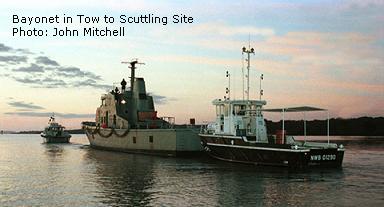
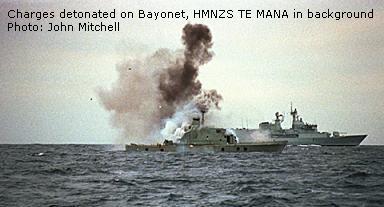
The official surveyor report logged BAYONET in 80 metres of water.
Expedition Planning
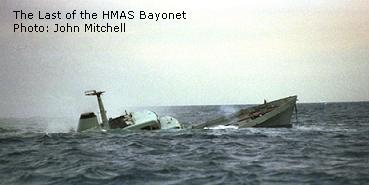 The exploration of a completely unknown area of ocean is daunting, as reliable information on weather conditions, site conditions, shipping, marine animals and other hazards are at best sketchy.
The exploration of a completely unknown area of ocean is daunting, as reliable information on weather conditions, site conditions, shipping, marine animals and other hazards are at best sketchy.
Our first step was to establish where BAYONET was scuttled; her position readily available on the Internet. We plotted the recorded position on admiralty chart AUS 788 only to find the wreck a substantial distance offshore - almost 50 kilometres south of Port Phillip Heads!
Our second step was to undertake a scouting mission to acquire additional information about the site and to establish the actual location of the wreck. On the 8th November 2000 the weather conditions proved stable enough to venture out to the scuttling area. At an average speed of around 30 knots the trip took 80 minutes. We found that Mobile phones only worked up to 20 kilometres offshore and the VHF Marine Radio experienced inconsistent reception from 40 kilometres+ offshore back to the Dive Victoria base station located in Portsea. Once we reached the reported scuttling site, we found no wreck and proceeded to do a parallel search pattern in an effort to locate her. Around 30 minutes later the depth sounder revealed the definite shape of a wreck resting in 82 metres of water. We launched a shot line into the water to ascertain ocean currents and found that a significant current was running. Satisfied that the scouting trip was a success, we retrieved the shot line and proceeded back to base recording the total round-trip distance between Sorrento and the BAYONET as 120 kilometres; total fuel used as 180 litres; and total travel time as 3 hours.
Risk Assessment and Acceptance
By this stage we knew where the wreck was located and had the means to dive her. But before diving the wreck we thought it prudent to identify and minimize the risks involved.
We identified the following potential risks and prioritised them in order of highest risk to lowest risk:
- Dive Platform;
- Weather Conditions;
- Site Conditions
- Diver Team;
- General Diving Hazards;
The dive platform was deemed to be the most important aspect of the entire expedition. Without a suitable seaworthy boat we would not attempt to dive the BAYONET. We felt Red October was suitable for the expedition as it was purposely configured as an offshore dive boat that meets Marine Survey standards. The vessel is a 7.2 metre plate alloy runabout with Twin Honda 115 hp 4—stroke engines. In the event of one engine failing, we would still be able to return on a single engine — albeit slowly. The boat is also fully equipped with all standard safety equipment. As a result of the SCUBA gear requirements to conduct such a deep dive, it was decided that the expedition would be limited to four divers and two deck crew.
Weather in Bass Strait is unpredictable at the best of times. Over the past 2 years we have become increasingly disappointed at the Bureau of Meteorology's ability to forecast weather conditions in the region; many a day has been wasted because of the vast discrepancy between forecast and actual conditions. We tend to err on the side of caution preferring to be conservative rather than gung-ho to the point where safety is compromised. After careful consideration we decided to wait for a day where weather conditions in the region would be stable for the next 24 hours with a wind forecast of 10 knots or less from the north and a maximum wave height of 1 metre. During 2001 we cancelled a number of attempts at diving BAYONET because of actual conditions encountered at the boat ramp far exceeded forecast conditions.
Only limited information was available about the dive site. The scouting mission had found the depth of water to be 82 metres and the admiralty chart listed ocean currents in the area of up to 3 knots. Following standard technical practice, all divers had to carry their own surface marker buoy (liftbag) and reel with sufficient line to launch from the ocean floor. This way if a diver became separated from the wreck due to strong currents, the crew on Red October could track their movement. The other concern about the dive site was whether it was clear of shipping hazards. While the BAYONET was scuttled outside of known shipping channels, we were instructed that we could not be guaranteed that a ship would not pass through the area. Suffice to say that this was a significant concern to all divers. To minimize this risk the Red October crew were to monitor VHF Channel 16 for shipping movements in the area and if necessary to advise any approaching ships of divers in the water.
Due to the expeditionary nature of the dive, selection of suitable divers was of paramount importance. A large number of divers expressed interest in being the first to dive the BAYONET and to narrow this field down to just four divers it was decided that the following prerequisites needed to be met by each diver:
- Recognized trimix certification;
- Recent experience at trimix diving;
- Adequately equipped and maintained dive gear;
- A mindset of self sufficiency and not dependency on their buddy;
- Had undertaken at least two dives off Red October so as to be familiar with entry/exit procedures of the vessel.
General Diving Hazards best describes all other risks. In this category we were specifically concerned about decompression sickness (DCS), hypothermia, and dangerous marine animals.
An inherent risk of mixed gas diving is DCS. This risk can be managed through the adoption of a conservative dive profile and correct diving technique, but can never be eliminated. If a diver gets a bend out on site they are 3 hours away from receiving medical attention. To alleviate DCS symptoms and provide a diver with the best chance of a recovery, a DAN first-aid kit is carried onboard and all divers are trained in its correct use.
In the summer months the water temperature in Bass Strait averages 18 degrees, while during winter drops to a cool 13 degrees. The helium content in trimix tends to conduct heat away from the body, thus accelerating the effects of hypothermia. The use of dry suits was subsequently deemed mandatory and in water dive time kept to under 90 minutes.
Dangerous marine animals, specifically sharks, posed more of a psychological risk rather than physical one. Sharks, like other marine animals tend to be weary of divers. However, this did not prevent a large number of people expressing a concern that the group run an increased risk of encountering deep-water sharks that far offshore. Popular theory suggested that sharks were attracted to the magnetic field generated by outboard engines, a story reinforced by a number of commercial fishermen. In the end we decided that the best thing to do was to limit a diver's exposure to sharks by minimizing the time a diver spent on the surface. As it turned out, we did in fact encounter a rather large shark while descending the shot line, but it soon disappeared after it decided that its next meal was not going to be us.
Dive Planning
As mentioned previously, a conservative dive profile would reduce our inherent risk of DCS. The use of trimix would require each diver to carry four tanks. The team felt the preferred gas mixtures for the dive be:
- NITROX 30 for the travel gas, used from the surface to 30 metres during the descent and from 40 metres to 15 metres during the ascent;
- TRIMIX 14/45 (14% oxygen, 45% helium) used for the bottom gas between descending past 30 metres and ascending back to 40 metres;
- NITROX 60 for the decompression gas to be used while ascending from 15 metres.
As an additional safety factor, a diver could choose to breathe pure oxygen in the final 15 minutes of the dive while following a NITROX 60 decompression schedule. This strategy was accepted by the team as a way of further reducing the risk of DCS. Each diver would carry sufficient gas to complete the dive, using the rule of thirds, the optional oxygen bottle (100 cubic foot) being attached to the shot line at 3 metres with multiple second stage regulators.
For the initial dive we decided to limit our bottom time to 15 minutes. The dive schedule was calculated with a conservatism factor of 25% for a total in water time of 82 minutes comprising of:
- 5 minutes to descend the shot line;
- 10 minutes on the bottom;
- 67 minutes to ascend the shot line and complete all the necessary decompression stops.
Dive schedules were printed and laminated for underwater use. Bottom times of 10, 15, 18 and 20 minutes with bail outs for loss of bottom gas, travel gas and decompression gas were produced.
We estimated that an uneventful trip would take around 5 hours to complete, but may go as high as 8 hours if we encountered any problems. We left full details of the expedition with family and friends advising of search details and emergency contact points if we had not checked in within 8 hours of departure.
The Day Arrives
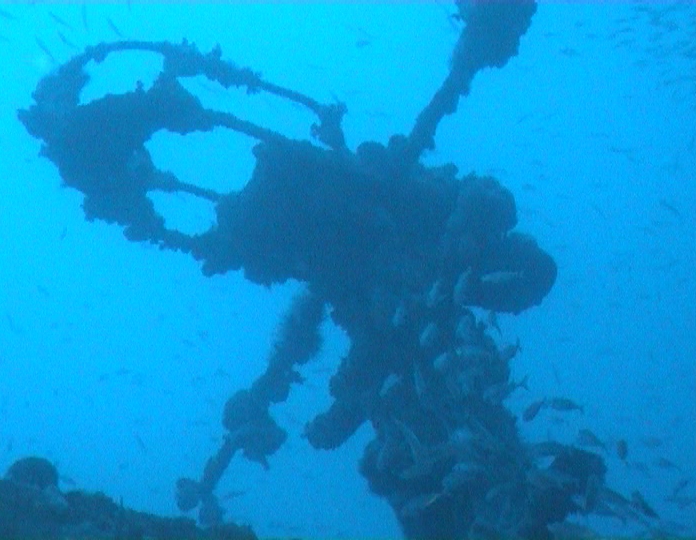 On Sunday 23rd December 2001 weather conditions were deemed satisfactory for the dive. Departing Sorrento at 8:00 am we passed through the heads and commenced the long journey out to the dive site. After what seemed like an eternity we arrived around 9:20 am and immediately dropped a shot line onto the wreck. A light current was visible on the line. We donned our gear and by 9:40 am had entered the water to encounter that the current had dropped away altogether. While descending the line a large shark swam past, but seemed more interest in things other than us. The water clarity was sensational and after a few minutes we reached the ocean floor only to discover a flat sandy bottom devoid of any wreck. Little did we know that since leaving the boat the shot had dragged off the wreck, all that was evident were drag marks in the sand that disappeared into the blue water. We followed the drag marks and after about a minute encountered BAYONET's anchor, attached to it was a line ascending vertically above us. Then, as if someone had turned on a light switch, she appeared no more than 10 metres from the anchor as if ready to set sail. BAYONET had settled on the ocean floor in an upright position and from our vantage point we could along the entire length of the wreck, some 50+ metres.
On Sunday 23rd December 2001 weather conditions were deemed satisfactory for the dive. Departing Sorrento at 8:00 am we passed through the heads and commenced the long journey out to the dive site. After what seemed like an eternity we arrived around 9:20 am and immediately dropped a shot line onto the wreck. A light current was visible on the line. We donned our gear and by 9:40 am had entered the water to encounter that the current had dropped away altogether. While descending the line a large shark swam past, but seemed more interest in things other than us. The water clarity was sensational and after a few minutes we reached the ocean floor only to discover a flat sandy bottom devoid of any wreck. Little did we know that since leaving the boat the shot had dragged off the wreck, all that was evident were drag marks in the sand that disappeared into the blue water. We followed the drag marks and after about a minute encountered BAYONET's anchor, attached to it was a line ascending vertically above us. Then, as if someone had turned on a light switch, she appeared no more than 10 metres from the anchor as if ready to set sail. BAYONET had settled on the ocean floor in an upright position and from our vantage point we could along the entire length of the wreck, some 50+ metres.
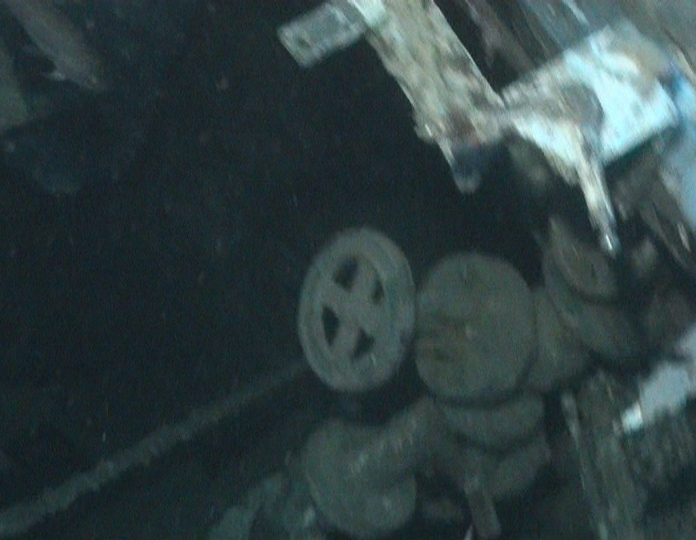 Around the base of the wreck steep sand ripples were present, a testament to the strong ocean currents that apparently rage through the area. The state of the hull was surprisingly "clean" with the painted water line markings on the bow still readable. We reached the base of the bow and obtained a reading of 82 metres and then ascended to BAYONET's deck, which sat in an average depth of 70 metres. A hole in the fore deck was the only remnants of BAYONET's forward gun. Proceeding to the cabin we noticed that a substantial amount of wiring was still present in the wreck along with an assortment of other "junk". We circled the cabin and briefly investigated the stern section before proceeding back to the shot line.
Around the base of the wreck steep sand ripples were present, a testament to the strong ocean currents that apparently rage through the area. The state of the hull was surprisingly "clean" with the painted water line markings on the bow still readable. We reached the base of the bow and obtained a reading of 82 metres and then ascended to BAYONET's deck, which sat in an average depth of 70 metres. A hole in the fore deck was the only remnants of BAYONET's forward gun. Proceeding to the cabin we noticed that a substantial amount of wiring was still present in the wreck along with an assortment of other "junk". We circled the cabin and briefly investigated the stern section before proceeding back to the shot line.
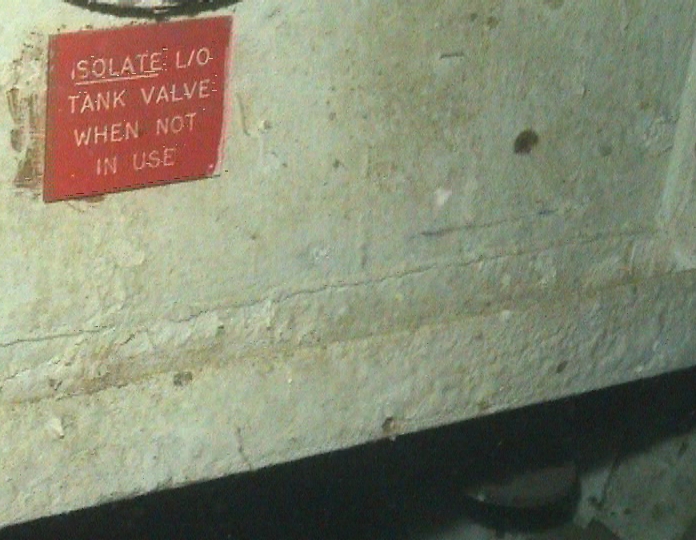 Unlike similar deep dives, the time passed quickly while we completed our mandatory decompression schedule. Upon surfacing exhilarated screams of joy filled the air. And after boarding Red October we stowed our gear and reviewed the dive during the long trip back to Sorrento, which seemed to pass much quicker than the trip out.
Unlike similar deep dives, the time passed quickly while we completed our mandatory decompression schedule. Upon surfacing exhilarated screams of joy filled the air. And after boarding Red October we stowed our gear and reviewed the dive during the long trip back to Sorrento, which seemed to pass much quicker than the trip out.
Back at Sorrento we checked in with family and friends who were pleased that we all returned in one piece. Our first expeditionary dive was a success.
Conclusion
During the past year we have enjoyed some exciting adventures. In the year ahead we plan on continuing this tradition by further exploring the Ships' Graveyard and revisiting wrecks like the BAYONET.

